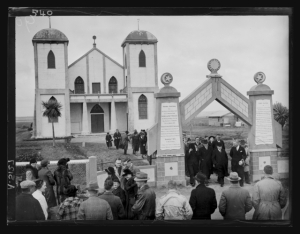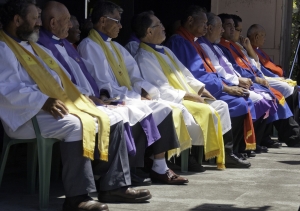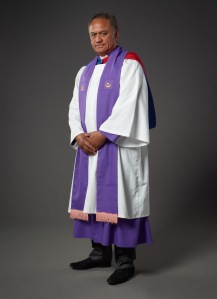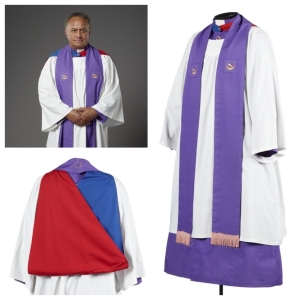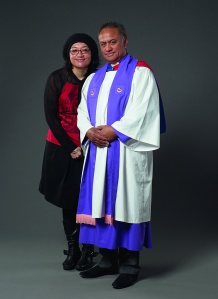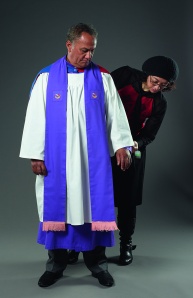ME024090; Āpotoro Rēhita Haahi Rātana Kākahu (Registered Apostle Ratana Church religious clothing)
Continuing the blogging about some of the key uniforms and acquisitions for the Uniformity exhibition, this blog is going to talk about one of my favourite uniforms in the show: the robes of an Āpotoro Rēhita from the Rātana Church and a uniform with which I have a personal affinity.
What is Rātana?
Rātana is a Māori adaptation of the Judeo-Christian tradition. Founded in 1918 by T.W. Rātana (1873–1939), Rātana has become a major Māori church in New Zealand with over 45, 000 Morehu or followers (as at the 2006 census). T.W. Rātana was raised Presbyterian with Wesleyan influences, so it is highly likely this religious familiarity has influenced the presentation of the Rātana kākahu, which show a distinct and direct correlation to the Protestant ecclesiastical vestments. The clothing that symbolised authority within the Protestant faith was adapted as the symbols of authority and leadership in the Rātana faith.
From its establishment to today, the RātanaChurch continues its role as an important faith and guide to many Māori across the country, and T.W. Rātana had a major impact on Māori leadership in the twentieth century.
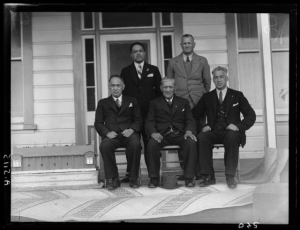
A.005115; Ratana; about 1933; Raine, William Hall.
5 men (all 5 wearing suits), on house porch, attending the 60th birthday celebrations of Tahu Potiki Wiremu Ratana (centre, front row) :- Back row (left to right) – PK Paikea, T Omana. Front row (lerft to right) – HT Ratana, Tahu Potiki Wiremu Ratana and ET Tirikatene.
Rātana Ministerial Uniforms
Uniforms are of great importance to the RātanaChurch, especially as visual signifiers of the specific roles and duties of the wearer. There are three levels of Āpotoro – three different ministers/readers, and each of these is identifiable by their various prescribed uniforms.
In the image below, you can see three types of minister uniforms.
The Āpotoro Rēhita or the Registered Apostle is an official registered minister who not only has spiritual duties but also legal. They are legally mandated to carry out the similar duties as a Justice of the Peace. (Purple cassock, white surplice, purple stole)
There are also the Āpotoro Wairua, the lay-readers, who support many followers of the Rātana Faith with spiritual counsel and guidance. (Blue robe, red stole)
There are the Akonga, or the disciples in training. (White surplice, yellow stole)
Colour origins
The design origins of the Rātana ministerial clothing lie within the Old Testament within the Exodus gospel: “And of the blue, and purple, and scarlet, they made cloths of service to do service in the holy place, and made the holy garments for Aaron; as the Lord commanded Moses. (Exodus 39, 1)
The Donor – Mita Ririnui
These kākahu were gifted by Honourable Mita Ririnui, a retired Labour MP for the Waiariki District and an Apōtoro Rēhita in the RātanaChurch for the last 25 years. He lives in Tauranga, where he was born and raised, and is of Ngāti Ranginui, Ngāi Te Rangi and Ngāti Pukenga descent. He continues to carry out Treaty Settlement work following his retirement from Parliament in 2011 and was raised in the RātanaChurch:
“I have always been a member of the Rātana Church, my dad was a member of the Rātana Church, my granddad was a member of the Rātana Church so that’s the only religion I have ever known. …. I have always followed the philosophy of the RātanaChurch; much of it has been instrumental in my upbringing.” (Mita Ririnui, interview with the Curator, 14 June 2012).
Mita became an Ākonga at the relatively young age of 27 and just a few years later he was made an Āpotoro Rēhita. His ascension within the church not only meant a commitment by him as the individual, it also required the commitment of his wider whanau. He described the special process in acquiring his appropriate robes for his new roles and the involvement of his family, almost as a rite of passage:
“My family gave me my kākahu – my first set of kākahu were my lay reader’s kākahu. My dad and his sisters gave me those. They were the only set of kākahu I had for that particular tūranga (appointment). When I graduated to the next level as an Āpotoro Wairua, the responsibility was mine from thereon…and so when I was appointed the position, I made a deliberate approach to the church authorities and presented my certificate. And once it had been signed, I made a deliberate attempt to purchase my own, because it had to be mine. And because the role became more important I had to take total responsibility.” (Mita Ririnui, interview with the Curator, 14 June 2012)
The Āpotoro Rēhita robes that he wore as a Registered Apostle were, in the end, paid for by Mita and his father. The involvement of family in the ordination and robing was significant. To acquire the robes, the pair made a trip to the Rātana Pā near Whanganui.
“They’re only made in the church office, RatanaPa – these lovely ladies in the back room, with their sewing machines, having been seamstresses in previous lives, and I’d like to say made to measure, but they fitted me perfectly.” (Mita Ririnui, interview with the Curator, 14 June 2012)
Mita was then 30 years old, and still continues to practice today as an Āpotoro Rēhita.
On a slightly more personal note, while I was brought up Katorika or Catholic, I was also raised alongside many of my extended family and members of my tribes who belonged to the Rātana church. Indeed three of my grandparents were raised Rātana (until my maternal grandmother converted to Catholicism after marrying my grandfather). So the Rātana church had a very strong presence in my childhood and I’ve always loved the colours and sounds of Rātana – their striking purple uniforms, hymns, the thunder and lament of the Rātana Brass Bands (otherwise called the Reo), and the solemnity of the spiritual Āpotoro. And in this, there were memories of watching uncles who were Āpotoro, dress in their Āpotoro robes, in readiness for Whakamoemiti or prayer service. There was a tangible sense of transformation and reflection as they dressed. In that short small and informal ritual of donning their robes over their everyday clothes they stopped being our uncles, and became spiritual leaders. I wanted to duplicate this process somehow in the Uniformity exhibition.
When I explained this to the Uniformity exhibition team and to Mita, they were in full support. And with huge amount of gratitude to the generosity of Mita, we were able to film the following clip here in our studio at Te Papa. We filmed his dressing process in the morning, and in the afternoon, I interviewed him about his life in the church and as an Āpotoro.
The result of the filming was the following short AV, in which Mita recounts the significance of the robes and their coded meaning, as he dons the garb in front of the camera.
I’m always interested in hearing and seeing your own memories of churches in your life. Please feel free to share images or stories, either of the RātanaChurch or of any other denomination.
He mihi:
Thank you to Mita Ririnui for his generosity in contributing to the Uniformity exhibition and sharing his personal stories with Te Papa.
Thank you also to Te Herekiekie Herewini, for peer reviewing this article.
Glossary:
Kākahu: Clothes, robes
Tūranga: appointed position
Āpotoro Rēhita: Registered Apostle
Āpotoro Wairua: Spiritual Apostle, Layreader
Ākonga: Acolyte, Learner
Whetū Marama: The crescent moon and star symbol of the RātanaChurch
Haahi: Church
Whakamoemiti: Pray, Prayer, Service
Whānau: family
Morehu; Rātana church followers

